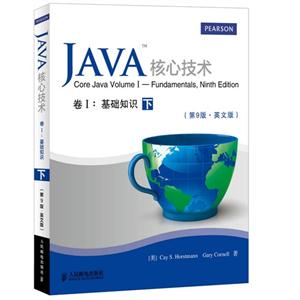JAVA核心技术-(上.下册)-(第9版.英文版)
本书特色
[
《java核心技术 卷i:基础知识(第9版 英文版)》是经典的java图书的*新版。这一版针对java se 7平台进行了全面更新。书中囊括了java的全部基础知识,提供了大量完整且具有实际意义的应用示例,详细介绍了java语言基础、面向对象编程、反射与代理、接口与内部类、事件监听器模型、使用swingui工具进行图形用户界面程序设计、打包应用程序、异常处理、登录与调试、泛型编程、集合框架、多线程等内容。
《java核心技术 卷i:基础知识(第9版 英文版)》适合想将java应用于实际项目的软件开发人员、高等院校教师和学生参考阅读。
]
内容简介
[
java经典图书*新版,前一版曾获得第13届jolt生产效率大奖。
java平台的权威指南,新版做了全面更新,体现了java se 7的变化,将对java se 7新特性的完整描述融入对java基本概念的精辟阐述中。
本书专为做实际项目的程序员编写,是一本真实可信、不偏不倚且简单直接的java教程,书中使用了全面测试过的代码示例来阐述关键的java语言与库的特性,体现了*佳的编程实践。
两位作者均是业内权威人物,有丰富的写作和实战经验。
]
作者简介
[
Cay S. Horstmann 是Scala for the Impatient的作者,还与人合著了Core JavaServer Faces。他是圣何塞州立大学计算机科学专业的教授,还是一名Java Champion,并经常在很多开发者大会上演讲。
Gary Cornell 在编程方面拥有20多年的写作和教育经验。他是Apress的创始人之一,编写了很多与开发相关的畅销书,是Jolt大奖的获奖者之一,还荣获过Visual Basic Magazine的读者选择奖。
]
目录
chapter 1: an introduction to java 1.1 java as a programming platform . 1.2 the java “white paper” buzzwords 1.2.1 simple 1.2.2 object-oriented 1.2.3 network-savvy 1.2.4 robust 1.2.5 secure 1.2.6 architecture-neutral . 1.2.7 portable . 1.2.8 interpreted 1.2.9 high-performance . 1.2.10 multithreaded 1.2.11 dynamic 1.3 java applets and the internet 1.4 a short history of java . 1.5 common misconceptions about java . chapter 2: the java programming environment 2.1 installing the java development kit 2.1.1 downloading the jdk . 2.1.2 setting the executable path 2.1.3 installing the library source and documentation . 2.1.4 installing the core java program examples 2.1.5 navigating the java directories . 2.2 choosing a development environment 2.3 using the command-line tools . 2.3.1 troubleshooting hints 2.4 using an integrated development environment . 2.4.1 locating compilation errors . 2.5 running a graphical application . 2.6 building and running applets . chapter 3: fundamental programming structures in java 3.1 a simple java program 3.2 comments 3.3 data types 3.3.1 integer types 3.3.2 floating-point types . 3.3.3 the char type . 3.3.4 the boolean type . 3.4 variables . 3.4.1 initializing variables . 3.4.2 constants 3.5 operators 3.5.1 increment and decrement operators . 3.5.2 relational and boolean operators . 3.5.3 bitwise operators 3.5.4 mathematical functions and constants . 3.5.5 conversions between numeric types 3.5.6 casts . 3.5.7 parentheses and operator hierarchy . 3.5.8 enumerated types . 3.6 strings . 3.6.1 substrings . 3.6.2 concatenation 3.6.3 strings are immutable 3.6.4 testing strings for equality 3.6.5 empty and null strings 3.6.5 code points and code units 3.6.6 the string api 3.6.7 readingthe online api documentation . 3.6.8 building strings . 3.7 input and output 3.7.1 reading input . 3.7.2 formatting output 3.7.3 file input and output . 3.8 control flow 3.8.1 block scope . 3.8.2 conditional statements . 3.8.3 loops . 3.8.4 determinate loops 3.8.5 multiple selections-the switch statement 3.8.6 statements that break control flow 3.9 big numbers 3.10 arrays 3.10.1 the “for each” loop 3.10.2 array initializers and anonymous arrays 3.10.3 array copying . 3.10.4 command-line parameters . 3.10.5 array sorting 3.10.6 multidimensional arrays . 3.10.7 ragged arrays . chapter 4: objects and classes 4.1 introduction to object-oriented programming 4.1.1 classes . 4.1.2 objects . 4.1.3 identifying classes 4.1.4 relationships between classes 4.2 using predefined classes . 4.2.1 objects and object variables . 4.2.2 the gregoriancalendar class of the java library . 4.2.3 mutator and accessor methods 4.3 defining your own classes . 4.3.1 an employee class 4.3.2 use of multiple source files 4.3.3 dissecting the employee class . 4.3.4 first steps with constructors . 4.3.5 implicit and explicit parameters . 4.3.6 benefits of encapsulation . 4.3.7 class-based access privileges . 4.3.8 private methods . 4.3.9 final instance fields 4.4 static fields and methods 4.4.1 static fields . 4.4.2 static constants 4.4.3 static methods 4.4.4 factory methods 4.4.5 the main method 4.5 method parameters . 4.6 object construction 4.6.1 overloading 4.6.2 default field initialization . 4.6.3 the constructor with no arguments 4.6.4 explicit field initialization . 4.6.5 parameter names 4.6.6 calling another constructor . 4.6.7 initialization blocks . 4.6.8 object destruction and the finalizeme
封面

书名:JAVA核心技术-(上.下册)-(第9版.英文版)
作者:霍斯特曼
页数:974
定价:¥109.0
出版社:人民邮电出版社
出版日期:2015-04-01
ISBN:9787115380371
PDF电子书大小:132MB 高清扫描完整版
